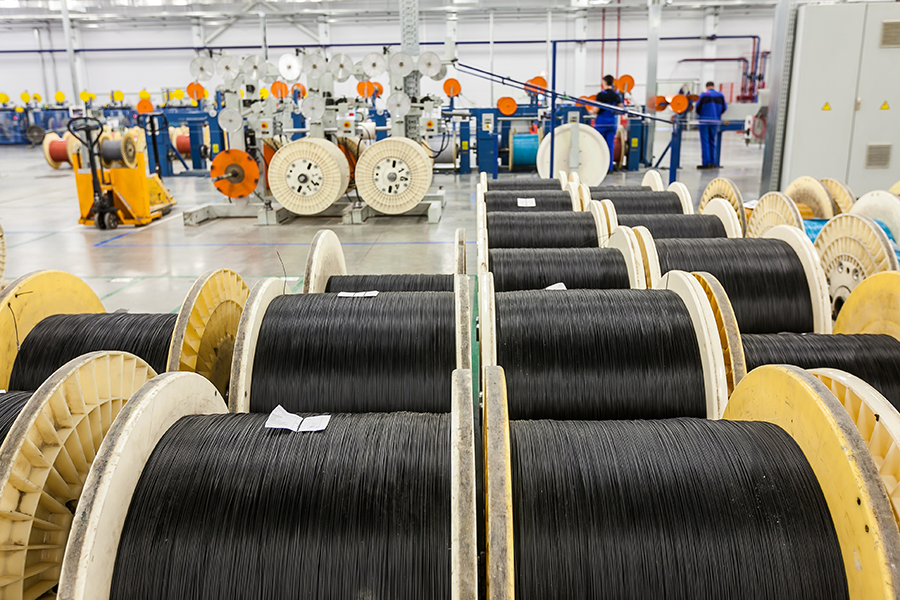

ການຜະລິດສາຍ
ໃນພູມສັນຖານທີ່ພັດທະນາຢ່າງໄວວາຂອງອຸດສາຫະກໍາທົ່ວໂລກ, ການປ່ຽນແປງໄປສູ່ຄວາມຍືນຍົງໄດ້ກາຍເປັນຈຸດປະສານງານທີ່ສໍາຄັນ. ການຜະລິດສາຍ, ພື້ນຖານໂຄງລ່າງທີ່ທັນສະໄໝ, ແມ່ນບໍ່ມີຂໍ້ຍົກເວັ້ນ. ໃນຂະນະທີ່ຄວາມກັງວົນດ້ານສິ່ງແວດລ້ອມເພີ່ມຂຶ້ນ, ອຸດສາຫະກໍາການຜະລິດສາຍເຄເບີ້ນແມ່ນນັບມື້ນັບຖືເອົາການປະຕິບັດສີຂຽວເພື່ອຫຼຸດຜ່ອນຮ່ອງຮອຍດ້ານນິເວດວິທະຍາຂອງຕົນ. ບົດຄວາມນີ້ delves ເຂົ້າໄປໃນວິທີການຜະລິດສາຍໄຟເປັນສີຂຽວ, ຄົ້ນຫາເຕັກໂນໂລຊີນະວັດຕະກໍາ, ວັດສະດຸທີ່ຍືນຍົງ, ແລະການລິເລີ່ມໃນທົ່ວອຸດສາຫະກໍາທີ່ກໍາລັງສ້າງອະນາຄົດທີ່ຍືນຍົງກວ່າ.


ການຜະລິດສາຍເຄເບີ້ນແມ່ນຂະແຫນງການທີ່ສໍາຄັນ, ການຜະລິດອົງປະກອບທີ່ສໍາຄັນສໍາລັບການສົ່ງໄຟຟ້າ, ໂທລະຄົມມະນາຄົມ, ແລະຄໍາຮ້ອງສະຫມັກເອເລັກໂຕຣນິກຕ່າງໆ. ແນວໃດກໍ່ຕາມ, ຂະບວນການຜະລິດພື້ນເມືອງສາມາດມີຊັບພະຍາກອນຫຼາຍແລະທໍາລາຍສິ່ງແວດລ້ອມ. ໂດຍການຮັບຮອງເອົາການປະຕິບັດສີຂຽວ, ອຸດສາຫະກໍາສາມາດຫຼຸດລົງຢ່າງຫຼວງຫຼາຍຜົນກະທົບຕໍ່ດາວເຄາະ, ອະນຸລັກຊັບພະຍາກອນ, ແລະປະກອບສ່ວນເຂົ້າໃນຄວາມພະຍາຍາມຂອງໂລກຕ້ານການປ່ຽນແປງຂອງດິນຟ້າອາກາດ.
ລັດຖະບານໃນທົ່ວໂລກພວມປະຕິບັດລະບຽບການດ້ານສິ່ງແວດລ້ອມທີ່ເຂັ້ມງວດເພື່ອສະກັດກັ້ນມົນລະພິດອຸດສາຫະກຳ ແລະ ຊຸກຍູ້ຄວາມຍືນຍົງ. ກົດລະບຽບເຫຼົ່ານີ້ບັງຄັບໃຫ້ຜູ້ຜະລິດສາຍເຄເບີ້ນປະຕິບັດການປະຕິບັດທີ່ເປັນມິດກັບສິ່ງແວດລ້ອມ, ເຊັ່ນ: ການຫຼຸດຜ່ອນການປ່ອຍອາຍພິດ, ການຫຼຸດຜ່ອນສິ່ງເສດເຫຼືອ, ແລະ ການນໍາໃຊ້ວັດສະດຸທີ່ຍືນຍົງ.
ຜູ້ບໍລິໂພກມີສະຕິຫຼາຍຂຶ້ນຕໍ່ຜົນກະທົບດ້ານສິ່ງແວດລ້ອມຂອງຜະລິດຕະພັນທີ່ເຂົາເຈົ້າຊື້. ການປ່ຽນແປງຂອງພຶດຕິກໍາຂອງຜູ້ບໍລິໂພກນີ້ແມ່ນເຮັດໃຫ້ຄວາມຕ້ອງການສໍາລັບສາຍທີ່ຜະລິດແບບຍືນຍົງ, ການຊຸກຍູ້ໃຫ້ຜູ້ຜະລິດຮັບຮອງເອົາການປະຕິບັດສີຂຽວເພື່ອຕອບສະຫນອງຄວາມຄາດຫວັງຂອງຕະຫຼາດ.
ບັນດາບໍລິສັດໄດ້ຮັບຮູ້ເຖິງຄວາມສຳຄັນຂອງຄວາມຮັບຜິດຊອບຕໍ່ສັງຄົມຂອງບໍລິສັດ ແລະ ພວມດຳເນີນບາດກ້າວບຸກທະລຸເພື່ອຫຼຸດຜ່ອນຜົນກະທົບຕໍ່ສິ່ງແວດລ້ອມ.. ໂດຍການຮັບຮອງເອົາການປະຕິບັດການຜະລິດແບບຍືນຍົງ, ຜູ້ຜະລິດສາຍສາມາດເສີມຂະຫຍາຍຊື່ສຽງຂອງເຂົາເຈົ້າ, ດຶງດູດລູກຄ້າທີ່ມີສະຕິຕໍ່ສິ່ງແວດລ້ອມ, ແລະປະກອບສ່ວນເຂົ້າໃນເປົ້າໝາຍຄວາມຍືນຍົງຂອງໂລກ.
ຫນຶ່ງໃນວິທີທີ່ມີປະສິດທິພາບທີ່ສຸດໃນການຫຼຸດຜ່ອນຜົນກະທົບດ້ານສິ່ງແວດລ້ອມຂອງການຜະລິດສາຍເຄເບີ້ນແມ່ນການນໍາໃຊ້ວັດສະດຸທີ່ນໍາມາໃຊ້ໃຫມ່. ຜູ້ຜະລິດກໍາລັງລວມເອົາໂລຫະທີ່ນໍາມາໃຊ້ໃຫມ່ຫຼາຍຂຶ້ນ, ເຊັ່ນ: ທອງແດງ ແລະອາລູມີນຽມ, ເຂົ້າໄປໃນຜະລິດຕະພັນຂອງພວກເຂົາ. ການນຳໃຊ້ວັດຖຸທີ່ນຳມາໃຊ້ໃໝ່ບໍ່ພຽງແຕ່ເປັນການອະນຸລັກຊັບພະຍາກອນທຳມະຊາດເທົ່ານັ້ນ ແຕ່ຍັງຊ່ວຍຫຼຸດຜ່ອນການບໍລິໂພກພະລັງງານ ແລະການປ່ອຍອາຍພິດເຮືອນແກ້ວທີ່ກ່ຽວຂ້ອງກັບການຂຸດຄົ້ນບໍ່ແຮ່ ແລະ ການກັ່ນທາດວັດຖຸດິບ..
ການສນວນສາຍເຄເບີ້ນແບບດັ້ງເດີມແລະວັດສະດຸ sheathing, ເຊັ່ນ: PVC ແລະ polyethylene, ສາມາດມີຂໍ້ບົກຜ່ອງດ້ານສິ່ງແວດລ້ອມທີ່ສໍາຄັນ. ເພື່ອແກ້ໄຂບັນຫານີ້, ຜູ້ຜະລິດກໍາລັງຫັນໄປສູ່ໂພລີເມີທີ່ຍ່ອຍສະຫຼາຍໄດ້ແລະຊີວະພາບ. ວັດສະດຸເຫຼົ່ານີ້, ໄດ້ມາຈາກແຫຼ່ງທົດແທນເຊັ່ນ: ແປ້ງສາລີ ແລະອ້ອຍ, ສະເຫນີລັກສະນະການປະຕິບັດທີ່ຄ້າຍຄືກັນໃນຂະນະທີ່ເປັນເປັນມິດກັບສິ່ງແວດລ້ອມຫຼາຍ.
ສານຕ້ານໄຟແບບດັ້ງເດີມທີ່ໃຊ້ໃນການຜະລິດສາຍເຄເບີ້ນມັກຈະມີ halogens, ເຊິ່ງສາມາດປ່ອຍອາຍພິດພິດອອກເມື່ອຖືກເຜົາ. ຕ້ານໄຟໄຫມ້ທີ່ບໍ່ມີ halogen, ຜະລິດຈາກວັດສະດຸເຊັ່ນອາລູມິນຽມ hydroxide ແລະ magnesium hydroxide, ໃຫ້ຄວາມຕ້ານທານໄຟທີ່ມີປະສິດທິພາບໂດຍບໍ່ມີຜົນກະທົບຕໍ່ສິ່ງແວດລ້ອມທີ່ເປັນອັນຕະລາຍ.
ຫຼັກການການຜະລິດແບບ lean ສຸມໃສ່ການຫຼຸດຜ່ອນສິ່ງເສດເຫຼືອແລະ optimizing ປະສິດທິພາບຕະຫຼອດຂະບວນການຜະລິດ. ໂດຍການປະຕິບັດການປະຕິບັດ lean, ຜູ້ຜະລິດສາຍສາມາດຫຼຸດຜ່ອນການບໍລິໂພກພະລັງງານ, ຫຼຸດຜ່ອນສິ່ງເສດເຫຼືອຂອງວັດສະດຸ, ແລະປັບປຸງຄວາມຍືນຍົງໂດຍລວມ.
ອັດຕະໂນມັດແລະຫຸ່ນຍົນແມ່ນການປະຕິວັດການຜະລິດສາຍໄຟໂດຍການເພີ່ມຄວາມແມ່ນຍໍາ, ການຫຼຸດຜ່ອນຄວາມຜິດພາດ, ແລະການເພີ່ມປະສິດທິພາບການນໍາໃຊ້ຊັບພະຍາກອນ. ລະບົບອັດຕະໂນມັດສາມາດປະຕິບັດວຽກງານໄດ້ຢ່າງຖືກຕ້ອງແລະສອດຄ່ອງຫຼາຍ, ນໍາໄປສູ່ສິ່ງເສດເຫຼືອຫນ້ອຍແລະການບໍລິໂພກພະລັງງານຕ່ໍາ.
ລະບົບການຟື້ນຕົວຂອງພະລັງງານຈະຈັບ ແລະນຳໃຊ້ພະລັງງານທີ່ຜະລິດຄືນໃໝ່ໃນລະຫວ່າງຂະບວນການຜະລິດ. ຕົວຢ່າງ, ຄວາມຮ້ອນທີ່ຜະລິດຈາກຂະບວນການ extrusion ສາມາດ harnessed ແລະນໍາໃຊ້ເພື່ອ preheat ວັດຖຸດິບ, ຫຼຸດຜ່ອນການບໍລິໂພກພະລັງງານໂດຍລວມແລະປັບປຸງປະສິດທິພາບ.
ການຜະລິດສິ່ງເສດເຫຼືອບໍ່ມີຈຸດມຸ່ງໝາຍເພື່ອກຳຈັດສິ່ງເສດເຫຼືອໂດຍການນຳກັບມາໃຊ້ໃໝ່, ການຣີໄຊເຄີນ, ຫຼືການຍ່ອຍສະຫຼາຍວັດສະດຸທັງຫມົດທີ່ກ່ຽວຂ້ອງກັບຂະບວນການຜະລິດ. ຜູ້ຜະລິດສາຍເຄເບີ້ນກໍາລັງປະຕິບັດຍຸດທະສາດເພື່ອບັນລຸເປົ້າຫມາຍທີ່ບໍ່ມີສິ່ງເສດເຫຼືອ, ເຊັ່ນການເພີ່ມປະສິດທິພາບການນໍາໃຊ້ວັດສະດຸ, ການຣີໄຊເຄີນວັດສະດຸເສດເຫຼືອ, ແລະ repurposing ຜົນຜະລິດຕະພັນ.
ການຣີໄຊເຄີນແບບວົງປິດ ປະກອບດ້ວຍການເກັບກຳ ແລະ ປຸງແຕ່ງສິ່ງເສດເຫຼືອຈາກຂະບວນການຜະລິດ ເພື່ອສ້າງຜະລິດຕະພັນໃໝ່.. ໃນການຜະລິດສາຍເຄເບີ້ນ, ນີ້ສາມາດປະກອບມີການລີໄຊເຄີນຂີ້ເຫຍື້ອທອງແດງແລະອາລູມິນຽມ, ເຊັ່ນດຽວກັນກັບການນໍາໃຊ້ວັດສະດຸ insulation ພາດສະຕິກ. ການຣີໄຊເຄີນແບບວົງປິດຊ່ວຍຫຼຸດຜ່ອນຄວາມຕ້ອງການວັດສະດຸເວີຈິນໄອແລນ ແລະຫຼຸດຜ່ອນສິ່ງເສດເຫຼືອທີ່ຖືກສົ່ງໄປບ່ອນຂີ້ເຫຍື້ອ.
ການແກ້ໄຂການຫຸ້ມຫໍ່ແບບຍືນຍົງ, ເຊັ່ນ: ການໃຊ້ວັດສະດຸທີ່ນຳມາໃຊ້ໃໝ່ ຫຼື ຍ່ອຍສະຫຼາຍໄດ້, ໄດ້ກາຍເປັນເລື່ອງທົ່ວໄປໃນອຸດສາຫະກໍາການຜະລິດສາຍເຄເບີ້ນ. ການຫຸ້ມຫໍ່ທີ່ເປັນມິດກັບສິ່ງແວດລ້ອມຫຼຸດຜ່ອນຜົນກະທົບດ້ານສິ່ງແວດລ້ອມຂອງການຂົນສົ່ງແລະການຈັດການສາຍ, ປະກອບສ່ວນເຂົ້າໃນຄວາມພະຍາຍາມເພື່ອຄວາມຍືນຍົງໂດຍລວມ.
ສາຍເຄເບີ້ນ superconducting, ຜະລິດຈາກວັດສະດຸທີ່ສາມາດນໍາໄຟຟ້າດ້ວຍຄວາມຕ້ານທານສູນ, ສະເຫນີຂໍ້ໄດ້ປຽບປະສິດທິພາບພະລັງງານທີ່ສໍາຄັນ. ສາຍເຫຼົ່ານີ້ສາມາດສົ່ງໄຟຟ້າໃນໄລຍະໄກໂດຍການສູນເສຍພະລັງງານຫນ້ອຍທີ່ສຸດ, ຫຼຸດຜ່ອນຄວາມຕ້ອງການການຜະລິດພະລັງງານເພີ່ມເຕີມແລະຫຼຸດຜ່ອນການປ່ອຍອາຍພິດເຮືອນແກ້ວ.
ສາຍ HVDC ແມ່ນປະສິດທິພາບຫຼາຍສໍາລັບ ການສົ່ງໄຟຟ້າທາງໄກ ເມື່ອປຽບທຽບກັບກະແສໄຟຟ້າສະຫຼັບແບບດັ້ງເດີມ (AC) ສາຍໄຟ. ໂດຍການຫຼຸດຜ່ອນການສູນເສຍພະລັງງານໃນລະຫວ່າງການສົ່ງ, ເທັກໂນໂລຍີ HVDC ສາມາດເສີມຂະຫຍາຍປະສິດທິພາບຂອງຕາຂ່າຍໄຟຟ້າ ແລະປະກອບສ່ວນເຂົ້າໃນໂຄງສ້າງພື້ນຖານດ້ານພະລັງງານທີ່ຍືນຍົງກວ່າ.
ສາຍໄຟເບີ optic, ເຊິ່ງໃຊ້ແສງເພື່ອສົ່ງຂໍ້ມູນ, ມີປະສິດທິພາບພະລັງງານຫຼາຍ ແລະມີຜົນກະທົບດ້ານສິ່ງແວດລ້ອມຕໍ່າກວ່າສາຍທອງແດງແບບດັ້ງເດີມ. ການນໍາໃຊ້ໃຍແກ້ວນໍາແສງໃນໂທລະຄົມນາຄົມແລະການສົ່ງຂໍ້ມູນຫຼຸດຜ່ອນຄວາມຕ້ອງການຂອງລະບົບເຮັດຄວາມເຢັນພະລັງງານຫຼາຍແລະຫຼຸດຜ່ອນສິ່ງເສດເຫຼືອເອເລັກໂຕຣນິກ..
ຜູ້ຜະລິດສາຍເຄເບີ້ນຈໍານວນຫຼາຍກໍາລັງນໍາໃຊ້ລະບົບການຄຸ້ມຄອງສິ່ງແວດລ້ອມ (EMS) ຄຸ້ມຄອງຜົນກະທົບດ້ານສິ່ງແວດລ້ອມຢ່າງເປັນລະບົບ. ກອບ EMS, ເຊັ່ນ ISO 14001, ໃຫ້ຄໍາແນະນໍາສໍາລັບການກໍານົດເປົ້າຫມາຍສິ່ງແວດລ້ອມ, ການຕິດຕາມປະສິດທິພາບ, ແລະສືບຕໍ່ປັບປຸງການປະຕິບັດຄວາມຍືນຍົງ.
ການຮ່ວມມືລະຫວ່າງພາກສ່ວນກ່ຽວຂ້ອງຂອງອຸດສາຫະກໍາ, ລວມທັງຜູ້ຜະລິດ, ຜູ້ສະໜອງ, ແລະລູກຄ້າ, ມີຄວາມສຳຄັນຕໍ່ການກ້າວໄປສູ່ການລິເລີ່ມຄວາມຍືນຍົງ. ສະມາຄົມອຸດສາຫະກໍາແລະຄູ່ຮ່ວມງານສົ່ງເສີມການແບ່ງປັນຄວາມຮູ້, ການປະຕິບັດທີ່ດີທີ່ສຸດ, ແລະການປະຕິບັດລວມຕໍ່ການຜະລິດສາຍໄຟສີຂຽວ.
ການລົງທຶນໃນການຄົ້ນຄ້ວາແລະການພັດທະນາແມ່ນການຂັບເຄື່ອນນະວັດຕະກໍາໃນການຜະລິດສາຍໄຟແບບຍືນຍົງ. ຣ&ຄວາມພະຍາຍາມ D ສຸມໃສ່ການພັດທະນາວັດສະດຸໃຫມ່, ປັບປຸງຂະບວນການຜະລິດ, ແລະຄົ້ນຫາເຕັກໂນໂລຊີທີ່ທັນສະໄໝເພື່ອເສີມຂະຫຍາຍຄວາມຍືນຍົງຂອງຜະລິດຕະພັນສາຍໄຟ.
ກຸ່ມສາຍ VERI, ເປັນຜູ້ນໍາທົ່ວໂລກໃນການຜະລິດສາຍເຄເບີ້ນ, ໄດ້ກ້າວໄປສູ່ຄວາມຍືນຍົງອັນສຳຄັນ. ບໍລິສັດໄດ້ປະຕິບັດນະໂຍບາຍດ້ານສິ່ງແວດລ້ອມທີ່ສົມບູນແບບລວມທັງການຫຼຸດຜ່ອນການປ່ອຍອາຍພິດເຮືອນແກ້ວ, ການຫຼຸດຜ່ອນສິ່ງເສດເຫຼືອ, ແລະນໍາໃຊ້ວັດສະດຸທີ່ຍືນຍົງ. ກຸ່ມ Prysmian ຍັງລົງທຶນໃນ R&D ເພື່ອພັດທະນາວິທີແກ້ໄຂສາຍເຄເບີນສີຂຽວແບບສ້າງສັນ, ເຊັ່ນ: ສາຍໃຍແກ້ວນໍາແສງປະສິດທິພາບສູງ ແລະສາຍສົ່ງພະລັງງານທີ່ມີປະສິດທິພາບສູງ.
Nexans, ຜູ້ນທີ່ສໍາຄັນອີກອັນຫນຶ່ງຂອງອຸດສາຫະກໍາສາຍເຄເບີ້ນ, is committed to sustainability through its “Nexans for Sustainable Development” program. ໂຄງການດັ່ງກ່າວສຸມໃສ່ການຫຼຸດຜ່ອນຜົນກະທົບຕໍ່ສິ່ງແວດລ້ອມຂະບວນການຜະລິດ, ສົ່ງເສີມປະສິດທິພາບພະລັງງານ, ແລະເພີ່ມທະວີການນໍາໃຊ້ຄືນໃຫມ່ຂອງຜະລິດຕະພັນສາຍເຄເບີນ. Nexans ຍັງຮ່ວມມືກັບພາກສ່ວນກ່ຽວຂ້ອງເພື່ອຊຸກຍູ້ການລິເລີ່ມຄວາມຍືນຍົງໃນທົ່ວອຸດສາຫະກໍາ.
ສາຍໄຟທົ່ວໄປ, ເປັນຜູ້ຜະລິດຊັ້ນນໍາຂອງຜະລິດຕະພັນສາຍແລະສາຍ, ໄດ້ປະສົມປະສານຄວາມຍືນຍົງເຂົ້າໃນຍຸດທະສາດທຸລະກິດຂອງຕົນ. ບໍລິສັດເນັ້ນຫນັກເຖິງການນໍາໃຊ້ວັດສະດຸທີ່ນໍາມາໃຊ້ໃຫມ່, ການຜະລິດພະລັງງານທີ່ມີປະສິດທິພາບ, ແລະການຫຼຸດຜ່ອນສິ່ງເສດເຫຼືອ. ຄໍາຫມັ້ນສັນຍາຂອງ General Cable ຕໍ່ກັບຄວາມຍືນຍົງແມ່ນສະທ້ອນໃຫ້ເຫັນໃນການຢັ້ງຢືນ ISO 14001 ແລະການມີສ່ວນຮ່ວມຂອງຕົນໃນການລິເລີ່ມຄວາມຍືນຍົງຂອງອຸດສາຫະກໍາຕ່າງໆ.
ອະນາຄົດຂອງການຜະລິດສາຍເຄເບີ້ນແມ່ນຢູ່ໃນການສືບຕໍ່ປະດິດສ້າງແລະຄໍາຫມັ້ນສັນຍາທີ່ຫມັ້ນຄົງຕໍ່ຄວາມຍືນຍົງ. ໃນຂະນະທີ່ເຕັກໂນໂລຢີກ້າວຫນ້າແລະຄວາມຮັບຮູ້ດ້ານສິ່ງແວດລ້ອມເພີ່ມຂຶ້ນ, ອຸດສາຫະກໍາຈະເຫັນການພັດທະນາຕື່ມອີກໃນວັດສະດຸສີຂຽວ, ຂະບວນການພະລັງງານປະສິດທິພາບ, ແລະຍຸດທະສາດການຫຼຸດຜ່ອນສິ່ງເສດເຫຼືອ. ເຕັກໂນໂລຊີທີ່ພົ້ນເດັ່ນຂື້ນ, ເຊັ່ນ: superconductors ກ້າວຫນ້າທາງດ້ານແລະເສັ້ນໄຍ optics ການຜະລິດຕໍ່ໄປ, ສາມາດປະຕິວັດອຸດສາຫະກໍາ ແລະປູທາງໄປສູ່ອະນາຄົດທີ່ຍືນຍົງກວ່າ.
Nanotechnology ແມ່ນ poised ມີບົດບາດສໍາຄັນໃນ ອະນາຄົດຂອງການຜະລິດສາຍໄຟສີຂຽວ. ວັດສະດຸ nanoscale ສາມາດເສີມຂະຫຍາຍປະສິດທິພາບແລະຄວາມຍືນຍົງຂອງສາຍໄຟໂດຍການສະຫນອງການ conductivity ດີກວ່າ, ຄວາມເຂັ້ມແຂງ, ແລະການຕໍ່ຕ້ານກັບປັດໃຈສິ່ງແວດລ້ອມ. ນອກຈາກນັ້ນ, nanotechnology ສາມາດນໍາໄປສູ່ການພັດທະນາໃຫມ່, insulation ເປັນມິດກັບສິ່ງແວດລ້ອມແລະວັດສະດຸ sheathing.
ການເຊື່ອມໂຍງຂອງເຕັກໂນໂລຢີ IoT ໃນການຜະລິດສາຍສາມາດເພີ່ມປະສິດທິພາບຂະບວນການຜະລິດ, ປັບປຸງປະສິດທິພາບພະລັງງານ, ແລະຫຼຸດຜ່ອນສິ່ງເສດເຫຼືອ. ເຊັນເຊີແລະລະບົບການຕິດຕາມທີ່ເປີດໃຊ້ IoT ສາມາດສະຫນອງຂໍ້ມູນໃນເວລາທີ່ແທ້ຈິງກ່ຽວກັບການບໍລິໂພກພະລັງງານ, ການນໍາໃຊ້ວັດສະດຸ, ແລະປະສິດທິພາບອຸປະກອນ, ເຮັດໃຫ້ຜູ້ຜະລິດສາມາດຕັດສິນໃຈຈາກຂໍ້ມູນເພື່ອເສີມສ້າງຄວາມຍືນຍົງ.
ການຮັບຮອງເອົາຮູບແບບເສດຖະກິດວົງໃນການຜະລິດສາຍເຄເບີ້ນກ່ຽວຂ້ອງກັບການອອກແບບຜະລິດຕະພັນສໍາລັບຄວາມທົນທານ, ການແກ້ໄຂ, ແລະການນໍາໃຊ້ຄືນໄດ້. ໂດຍການຂະຫຍາຍວົງຈອນຊີວິດຂອງສາຍແລະການສົ່ງເສີມການນໍາໃຊ້ຄືນໃຫມ່ຂອງອຸປະກອນການ, ອຸດສາຫະກໍາສາມາດຫຼຸດຜ່ອນການເພິ່ງພາອາໄສຊັບພະຍາກອນເວີຈິນໄອແລນແລະຫຼຸດຜ່ອນຜົນກະທົບຕໍ່ສິ່ງແວດລ້ອມ.
ການສຶກສາແລະການຝຶກອົບຮົມແມ່ນມີຄວາມຈໍາເປັນສໍາລັບການຂັບລົດຄວາມຍືນຍົງໃນການຜະລິດສາຍເຄເບີ້ນ. ໂດຍການຈັດໃຫ້ພະນັກງານມີຄວາມຮູ້ແລະທັກສະທີ່ຈໍາເປັນໃນການປະຕິບັດການປະຕິບັດສີຂຽວ, ບໍລິສັດສາມາດເສີມສ້າງວັດທະນະທໍາທີ່ມີຄວາມຍືນຍົງແລະຮັບປະກັນການຮັບຮອງເອົາເຕັກໂນໂລຢີແລະຂະບວນການທີ່ເປັນມິດກັບສິ່ງແວດລ້ອມຢ່າງປະສົບຜົນສໍາເລັດ.. ບັນດາໂຄງການຝຶກອົບຮົມໄດ້ສຸມໃສ່ການຜະລິດແບບ lean, ປະສິດທິພາບພະລັງງານ, ແລະການຫຼຸດຜ່ອນສິ່ງເສດເຫຼືອສາມາດສ້າງຄວາມເຂັ້ມແຂງໃຫ້ກໍາລັງແຮງງານເພື່ອປະກອບສ່ວນເຂົ້າໃນເປົ້າຫມາຍຄວາມຍືນຍົງຂອງອຸດສາຫະກໍາ.
ນະໂຍບາຍ ແລະ ແຮງຈູງໃຈຂອງລັດຖະບານສາມາດມີບົດບາດສໍາຄັນໃນການເລັ່ງການຮັບຮອງເອົາການປະຕິບັດສີຂຽວໃນການຜະລິດສາຍເຄເບີນ.. ໂດຍການໃຫ້ສິ່ງຈູງໃຈທາງດ້ານການເງິນ, ຜ່ອນພາສີ, ແລະການຊ່ວຍເຫຼືອລ້າສໍາລັບການລິເລີ່ມທີ່ຍືນຍົງ, ລັດຖະບານສາມາດຊຸກຍູ້ໃຫ້ບໍລິສັດລົງທຶນໃນເຕັກໂນໂລຊີ ແລະຂະບວນການທີ່ເປັນມິດກັບສິ່ງແວດລ້ອມ. ນອກຈາກນັ້ນ, ກົດລະບຽບທີ່ກໍານົດມາດຕະຖານສໍາລັບປະສິດທິພາບພະລັງງານ, ການປ່ອຍອາຍພິດ, ແລະການຄຸ້ມຄອງສິ່ງເສດເຫຼືອສາມາດຂັບເຄື່ອນການປະຕິບັດຕາມທົ່ວອຸດສາຫະກໍາແລະສົ່ງເສີມຄວາມຍືນຍົງ.
ການຫັນປ່ຽນໄປສູ່ການຜະລິດສາຍເຄເບີນສີຂຽວບໍ່ພຽງແຕ່ເປັນທ່າອ່ຽງເທົ່ານັ້ນ, ແຕ່ເປັນຄວາມຈຳເປັນໃນການປະເຊີນໜ້າກັບສິ່ງທ້າທາຍດ້ານສິ່ງແວດລ້ອມທີ່ເພີ່ມຂຶ້ນ. ໂດຍການຍຶດເອົາວັດສະດຸທີ່ຍືນຍົງ, ຂະບວນການພະລັງງານປະສິດທິພາບ, ແລະເຕັກໂນໂລຊີນະວັດກໍາ, ອຸດສາຫະກໍາການຜະລິດສາຍເຄເບີ້ນສາມາດຫຼຸດລົງຢ່າງຫຼວງຫຼາຍຂອງລະບົບນິເວດວິທະຍາແລະປະກອບສ່ວນໄປສູ່ອະນາຄົດທີ່ຍືນຍົງກວ່າ. ຄວາມພະຍາຍາມຮ່ວມມືຂອງຜູ້ຜະລິດ, ລັດຖະບານ, ແລະຜູ້ບໍລິໂພກແມ່ນມີຄວາມຈໍາເປັນໃນການຂັບເຄື່ອນການປ່ຽນແປງນີ້, ຮັບປະກັນວ່າການຜະລິດສາຍເຄເບີ້ນຍັງຄົງເປັນອຸດສາຫະກໍາທີ່ສໍາຄັນແລະມີຄວາມຮັບຜິດຊອບຕໍ່ສິ່ງແວດລ້ອມ. ໃນຂະນະທີ່ພວກເຮົາຊອກຫາອະນາຄົດ, ການສືບຕໍ່ປະດິດສ້າງ ແລະຄໍາໝັ້ນສັນຍາຕໍ່ຄວາມຍືນຍົງຈະເປັນກຸນແຈເພື່ອບັນລຸເປົ້າໝາຍສີຂຽວ, ຂະແໜງການຜະລິດສາຍໄຟແບບຍືນຍົງກວ່າ.
When people hear the term mineral insulated cable, many immediately think of harsh environments like…
As telecommunication networks and power transmission systems grow rapidly, the demand for reliable and cost-effective…
In large-scale oil and gas projects, industrial cables are not just accessories—they are the "nervous…
In the world of electrical connections, cable lugs—also known as cable ears or cable terminals—are…
When choosing the right rubber cable for an electrical engineering project, it is critical to…
Dear partners and customers: January 29th, 2025 is the Chinese Lunar New Year – Spring…